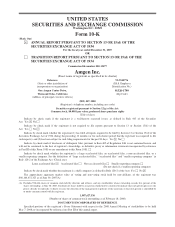Amgen 2007 Annual Report Download - page 21
Download and view the complete annual report
Please find page 21 of the 2007 Amgen annual report below. You can navigate through the pages in the report by either clicking on the pages listed below, or by using the keyword search tool below to find specific information within the annual report.result in extremely low numbers of neutrophils, a condition called neutropenia. Myelosuppressive chemotherapy,
one treatment option for individuals with certain types of cancers, targets cell types that grow rapidly, such as
tumor cells. Normal cells that also divide rapidly, such as those in the bone marrow that become neutrophils, are
also vulnerable to the effects of cytotoxic chemotherapy, resulting in neutropenia with an increased risk of severe
infection. Very often, neutropenia is the dose limiting side effect of chemotherapy and can thus be responsible
for a reduction in the amount of chemotherapy that can be administered safely. Such reductions in chemotherapy
dose can compromise the effectiveness of chemotherapy on the cancer it is being used to treat, with the result of
a higher treatment failure rate. As mentioned above, the pegfilgrastim molecule is based on the Filgrastim mole-
cule. A polyethylene glycol molecule or (“PEG”) is added to enlarge the Filgrastim molecule, thereby extending
its half-life and causing it to be removed more slowly from the body. Because pegfilgrastim is eliminated through
binding to its receptor on neutrophils and their precursors, pegfilgrastim remains in the circulation until neu-
trophil recovery has occurred. This neutrophil-mediated clearance allows for administration as a single dose per
chemotherapy cycle, compared with NEUPOGEN®, which requires more frequent dosing. Neulasta®is pre-
scribed more frequently in the curative setting, in which myelosuppressive chemotherapy is administered with
the intent to cure cancer, rather than in the palliative setting, in which myelosuppressive chemotherapy is ad-
ministered to treat other complications of cancer by managing tumor growth.
We were granted an exclusive license to manufacture and market pegfilgrastim in the United States, Europe,
Canada, Australia and New Zealand under a licensing agreement with KA (see “Joint Ventures and Business Re-
lationships — Kirin Holdings Company, Limited”).
We market Neulasta®primarily in the United States, Europe and Canada. Pegfilgrastim is marketed under
the brand name Neupopeg™ in Italy. Neulasta®was initially launched in the United States and Europe in 2002
and is indicated for reducing the incidence of infection associated with chemotherapy-induced neutropenia in
cancer patients with non-myeloid malignancies. Subsequently, the FDA approved an update to the Neulasta®
prescribing information to include data from a landmark phase 3 study demonstrating that Neulasta®helps pro-
tect patients with breast cancer undergoing moderately myelosuppressive chemotherapy from infection, as
manifested by febrile neutropenia. Administration of Neulasta®in all cycles of chemotherapy is now approved
for patients receiving myelosuppressive chemotherapy associated with at least a 17% risk of febrile neutropenia.
Worldwide Neulasta®sales for the years ended December 31, 2007, 2006 and 2005 were $3.0 billion, $2.7
billion and $2.3 billion, respectively.
NEUPOGEN®(Filgrastim)
NEUPOGEN®is our registered trademark for our recombinant-methionyl human granulocyte colony-
stimulating factor (“G-CSF”), a protein that selectively stimulates production of certain white blood cells known
as neutrophils (see “— Neulasta®(pegfilgrastim)” for additional information on neutrophils). Similar to Neu-
lasta®, NEUPOGEN®is prescribed more frequently in the curative setting, in which myelosuppressive
chemotherapy is administered with the intent to cure cancer, rather than in the palliative setting, in which myelo-
suppressive chemotherapy is administered to treat other complications of cancer by managing tumor growth.
We were granted an exclusive license to manufacture and market G-CSF in the United States, Europe, Cana-
da, Australia and New Zealand under a licensing agreement with KA (see “Joint Ventures and Business
Relationships — Kirin Holdings Company, Limited”).
We market NEUPOGEN®primarily in the United States, Europe and Canada. Filgrastim is marketed under
the brand name GRANULOKINE®in Italy. NEUPOGEN®was initially launched in the United States and Eu-
rope in 1991. NEUPOGEN®is indicated for reducing the incidence of infection as manifested by febrile
neutropenia for patients with non-myeloid malignancies undergoing myelosuppressive chemotherapy; reducing
the duration of neutropenia and neutropenia-related consequences for patients with non-myeloid malignancies
undergoing myeloablative chemotherapy followed by bone marrow transplantation; reducing the incidence and
duration of neutropenia-related consequences in symptomatic patients with congenital neutropenia, cyclic neu-
tropenia or idiopathic neutropenia (collectively, severe chronic neutropenia); mobilizing peripheral blood
progenitor cells (“PBPC”) in cancer patients who have undergone myeloablative chemotherapy for stem cell
9
























